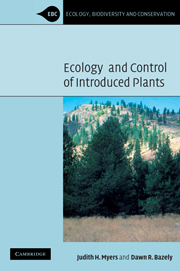Book contents
- Frontmatter
- Contents
- Preface
- 1 Introduction
- 2 Planet of Weeds: exotic plants in the landscape
- 3 Biological invasions in the context of plant communities
- 4 Predicting invasiveness from life history characteristics
- 5 Population ecology and introduced plants
- 6 Introduced plant diseases
- 7 Biological control of introduced plants
- 8 Modeling invasive plants and their control
- 9 Action against non-indigenous species
- 10 Genetically modified plants and final conclusions
- Appendix
- References
- Index
8 - Modeling invasive plants and their control
Published online by Cambridge University Press: 02 December 2009
- Frontmatter
- Contents
- Preface
- 1 Introduction
- 2 Planet of Weeds: exotic plants in the landscape
- 3 Biological invasions in the context of plant communities
- 4 Predicting invasiveness from life history characteristics
- 5 Population ecology and introduced plants
- 6 Introduced plant diseases
- 7 Biological control of introduced plants
- 8 Modeling invasive plants and their control
- 9 Action against non-indigenous species
- 10 Genetically modified plants and final conclusions
- Appendix
- References
- Index
Summary
Introduction
We would like to be able to predict the dynamics of introduced plant species in different situations, how they might respond to biological control, and how they might spread. Several different types of models have been used to integrate information on the populations of introduced species and their control. These models include (1) simulation models based on individual population units that can vary depending on survival and reproduction functions estimated from field studies and may involve stochasticity, (2) analytical models in which functions derived from simulation models or field measurements are used to describe the population processes, and (3) matrix models based on life table studies. In Chapter 5 we described the most basic aspects of population ecology – birth, immigration, death and emigration – and discuss how life tables could be used to summarize data on the transitions among different life stages. Also we described how the rate of growth, R0 or λ, of a population could be determined by relating the population density of one generation to that of the next. In this chapter we explore theoretical models of biological control, the use of models to study populations of introduced plant species, and then models of the spread of introduced species. The strengths and weaknesses of different models will be evaluated. A more extensive treatment of models of weed populations can be found in Cousens and Mortimer (1995).
- Type
- Chapter
- Information
- Ecology and Control of Introduced Plants , pp. 195 - 223Publisher: Cambridge University PressPrint publication year: 2003

